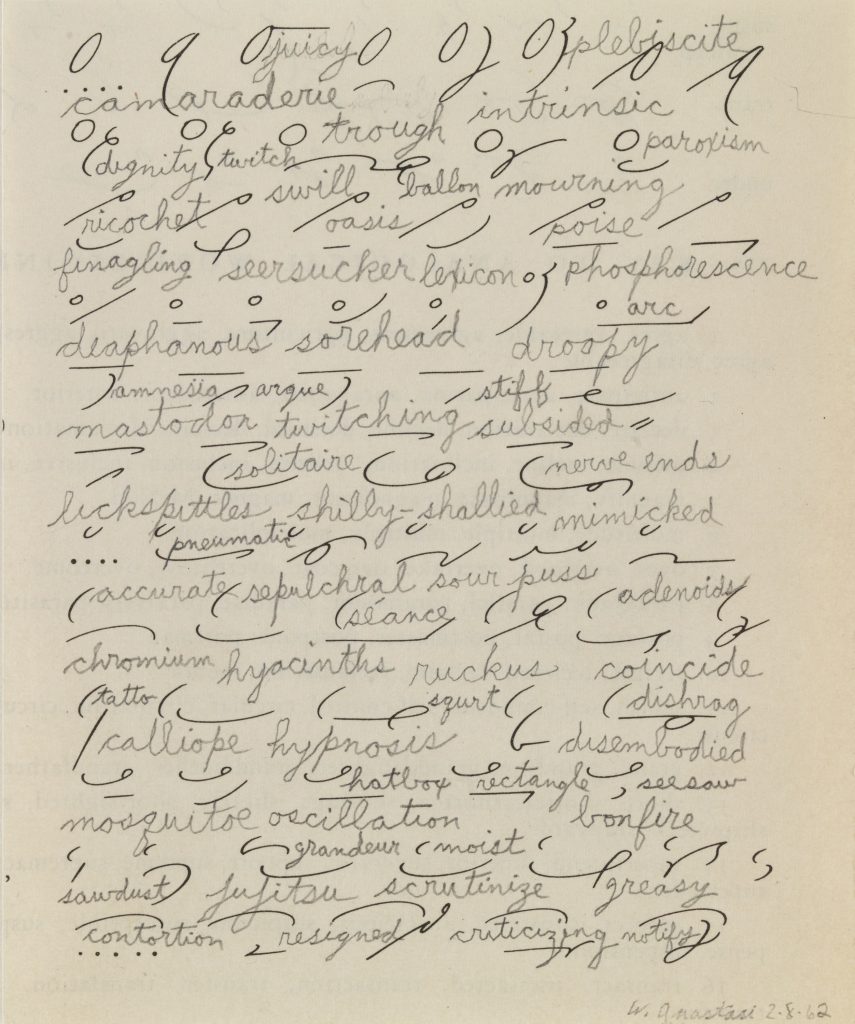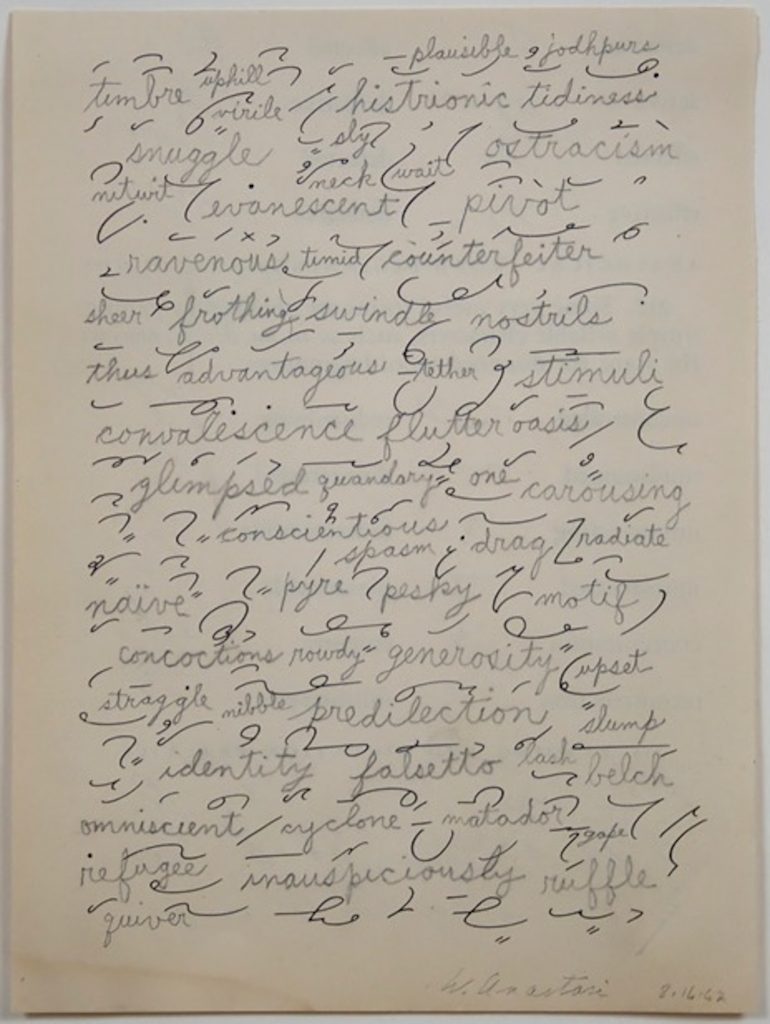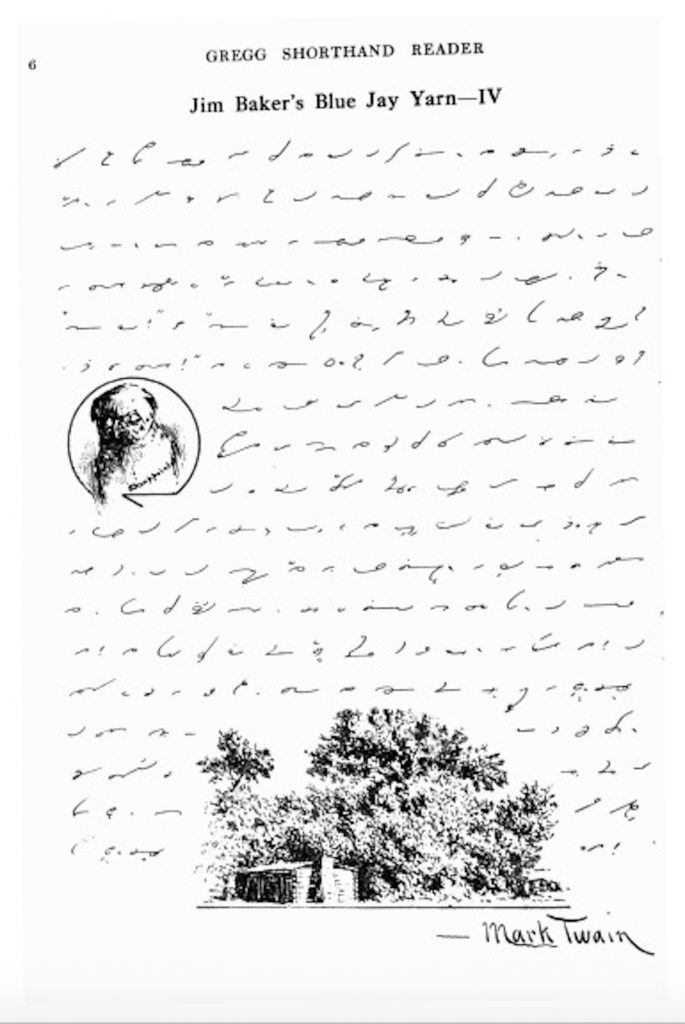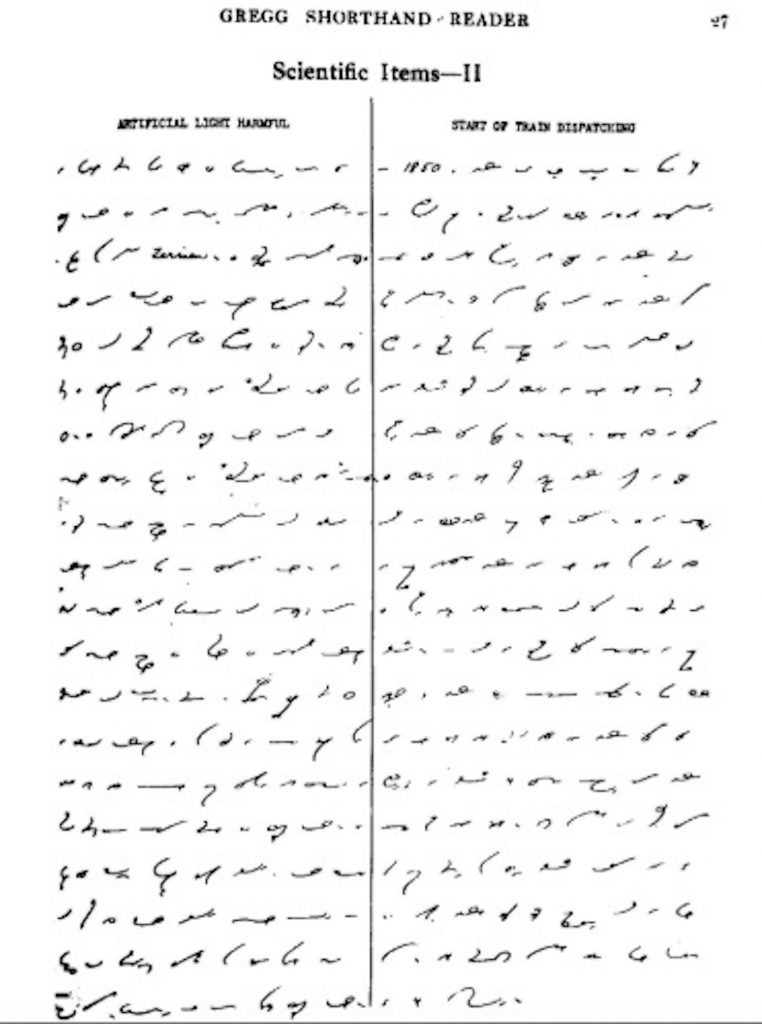Walk with Me: William Anastasi’s Stenography of the Street
In 1962, William Anastasi (b. 1933) moved into an apartment on Eighth Street between Avenues C and D in New York City, which at that time was a low-priced neighborhood of mixed Puerto Rican and German Jewish immigrants.1 A newcomer from Philadelphia, the twenty-seven-year-old, who had been working as a masonry contractor and brickwork salesman, planned to become an artist. Starting just five years later, he had four solo exhibitions in rapid succession at the Dwan Gallery, exhibitions that placed him squarely within the trajectory of that gallery as an emerging hub for Minimal and Conceptual artists.2 In these early years, however, Anastasi had given little thought to what kind of art he would produce in New York. The son of Sicilian immigrants and a divorced father of three, Anastasi was, by his own admission, driven first by a desire to move on from his work as a “bricklaying apprentice and owner of a masonry-contracting firm.” The activity that provided him with a stable framework for his ambition was drawing, which is something he had done “almost every other day since childhood.”3
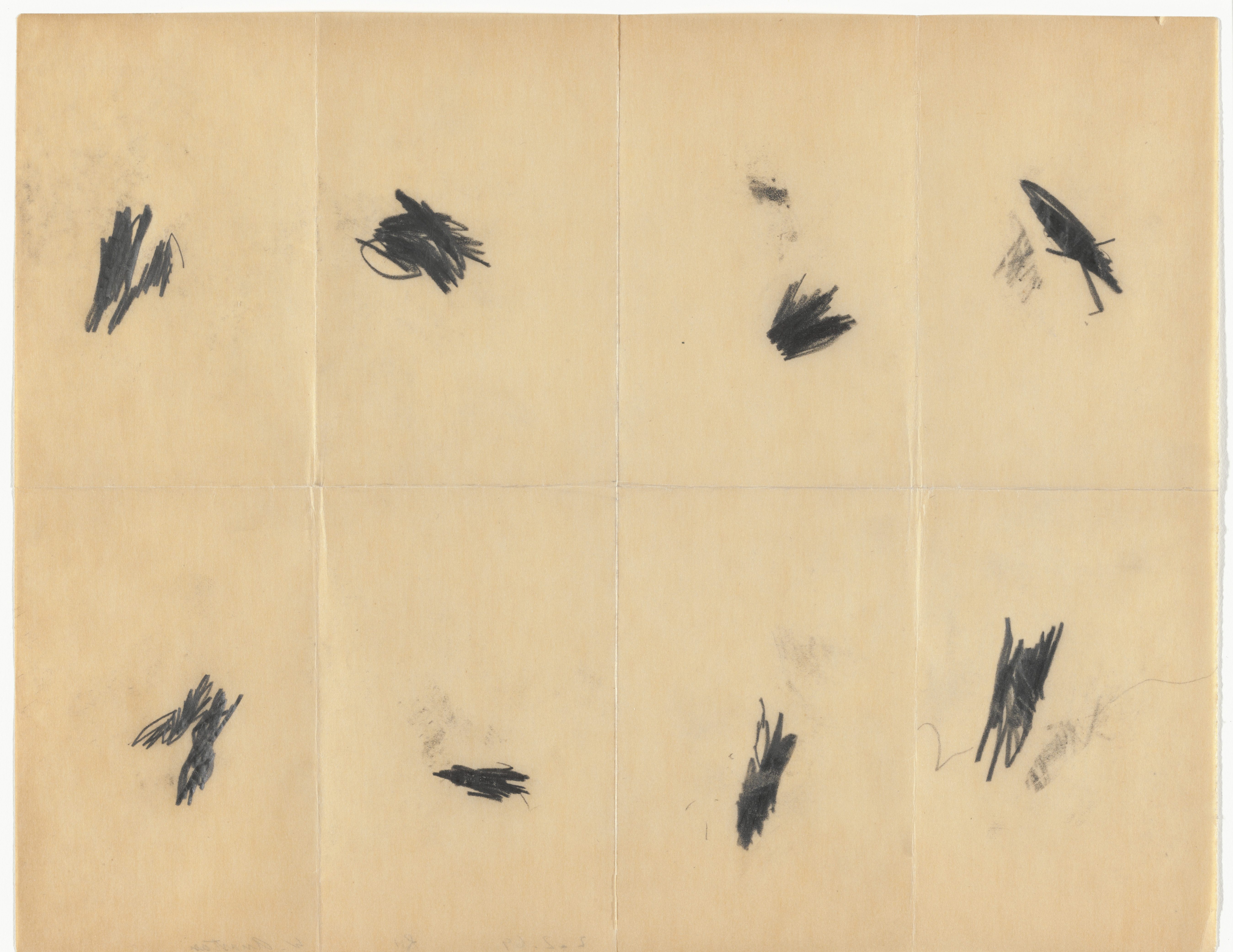
Once in New York, Anastasi wove drawing into his walks to and from his jobs in sales and service management and to screenings of silent films at the Museum of Modern Art (MoMA). He worked as a restaurant manager and also as a door-to-door salesman, selling photographic portrait packages for Olan Mills and books for Doubleday Press. These jobs were regimented—measured by footsteps taken and dollars earned—and contingent on maintaining a charismatic warmth and ease.4 His drawings, by contrast, were unstructured. He made them on small and portable sheets of paper that he could fold and place in his pocket (fig. 1). Anastasi refers to them now as “the walking drawings” and continues to produce them almost six decades later. To make these early versions, he loosely held a soft lead pencil and used it to mark a pocketed sheet of paper with pencil lines. The timbre and length of a line was determined by the roominess of the pocket on his blue jeans or work slacks. After walking and drawing for a bit, he would refold his paper, like a notetaker or a clerk folding a sales receipt, and start again. Later drawing series transcribed the physical experience of other daily tasks. He made the Constellation Drawings of 1962 and 1963, for instance, while listening to music, and the Subway Drawings (1977 to the present) harnessed the motion of the New York City subway to generate pencil or pen marks onto a paper that he balanced on his lap. In these situations, he adapted the act of drawing to accommodate his travels, which shaped his lines according to his environment, the fit of his garments, or restrictions on his proprioception.
Two other drawings on found paper produced in 1962, which also appear casual, reference transcription as a professional skill (figs. 2, 3). Using a practice page designed for professional stenographers, Anastasi penciled a series of words between the lined exercises, adapting his word choices to the available space on the printed page. Stenography, a popular profession in the 1960s, is a phonetic way of transcribing sensory data that requires vocational training; a stenographer writes down words as they are heard, dropping the silent letters in each word to make a compact approximation of it using symbols. Exercise books for stenographers used written drills to build transcription speed (figs. 4, 5). Anastasi could not read stenographic forms, so the two drawings convert a rigorous training space—the space of a profession he did not practice—into an arena for casual, ad hoc exploration. Anastasi recalls that for him, the practice pages presented a spatial puzzle: some spaces were “begging” for larger letters, while other parts of the page were so compact that he had to use his own shorthand to make them fit (such as squrt, in fig. 3).5 His cursive words are rich with consonants and diphthongs—the sounds that stenographers listen for in order to choose which symbols to write—which detaches them from their denotative meaning and renders them as auditory forms: lickspittles, chromium, amnesia. These words constitute a worthy stenographic drill in themselves.

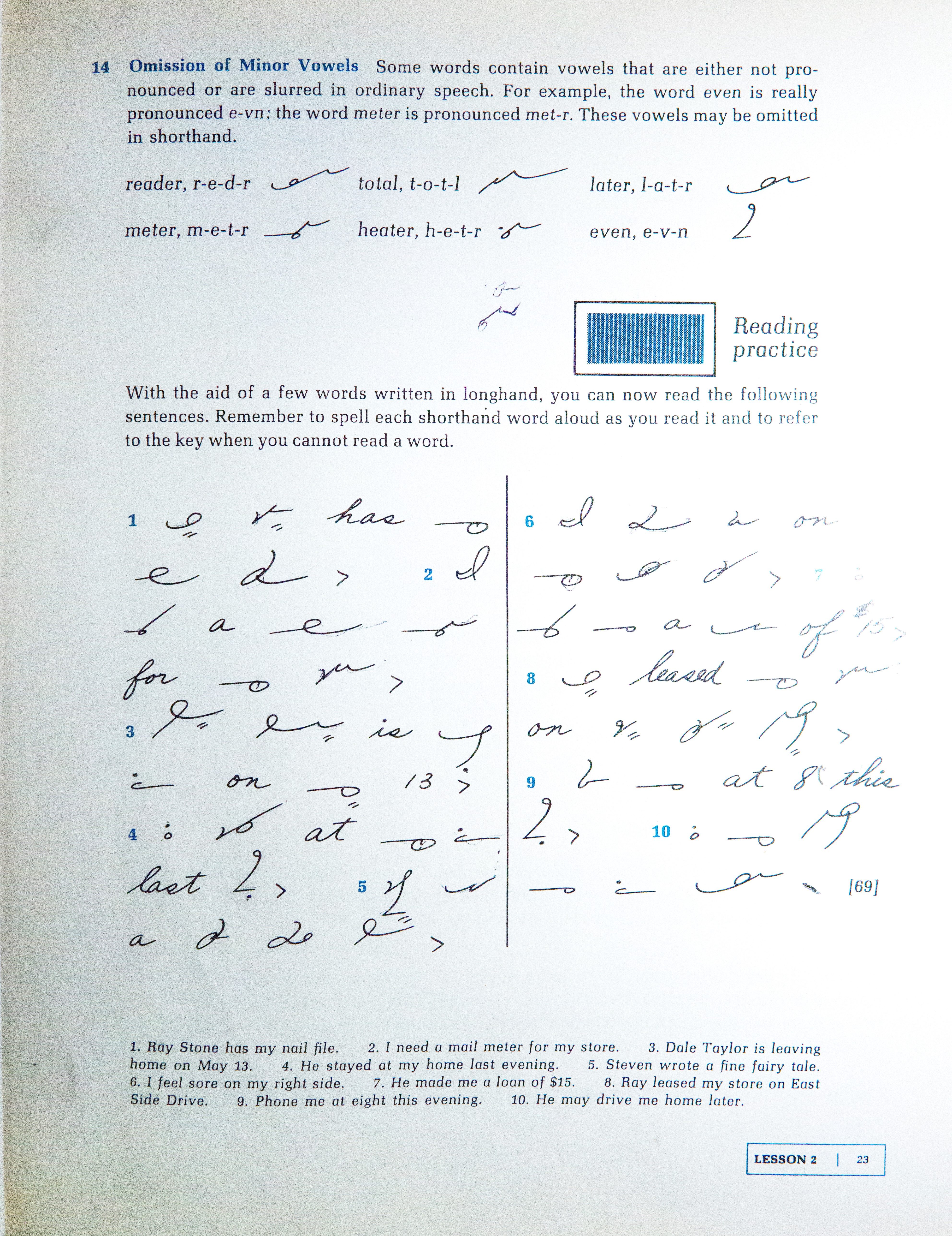
Anastasi experimented with other transcription technologies during the first two decades of his career. He played with phonograph needles and tape recorders, and he collaborated with court stenographers on stenotype machines, often using them for recording his (or each other’s) actions. In so doing, he, like many artists of his generation, obscured the sources and values of aesthetic meaning. His drawings, meanwhile, shifted the work of transcription away from his supposedly skilled hands and onto his body, which responded insentiently to his various environments and situations. In this essay, which focuses on Anastasi’s drawing practices, I argue that by making his reflexive bodily movements the sole source as well as the transcriber of his ideas, Anastasi mobilized the concept of know-how, or techne. He rigorously trained himself to do the drawings, but the goal of his training was to draw effortlessly, “like breathing.”6 He established a set of quasi-ecstatic, meditative strategies that shifted decision-making power onto trains, sidewalks, clothing, and urban infrastructure. In this way, he advanced the idea that any mark was as good as any other, regardless of the impulse or entity that generated it. Anastasi was an untrained artist who had formerly trained to be a contractor, and his sculptural work occasionally alluded to his construction skills.7 His drawing practice, however, helped him reconcile two emerging identities: one as a dedicated, ambitious artist and the other as an untrained amateur Conceptualist.
Scholars have tended to frame Anastasi’s works on paper in terms of their Surrealist lineage, positioning his speculative, seismographic drawings as a reworking of automatism—as an attempt to transcribe Surrealist tactics of the past into purely physical, rather than psychic, terms.8 Such tactics, however, can also be seen as part of a larger examination of work and agency in the burgeoning art world of the 1960s, when amateurism, liberation, and chicanery were playfully explored, but hard-nosed professionalism was necessary. Skill was at the forefront of artistic discourse in the Vietnam War era. Julia Bryan-Wilson and others have explored the implications of the terms “work” and “worker” for artists during this decade, pointing out that artists grafted different kinds of labor onto their respective practices, often in performative ways, extracting social and professional benefits as a result.9 Anastasi’s contemporaries, such as Robert Morris and Carl Andre, did this through tactics that, as Bryan-Wilson puts it, “connected art to work while also removing artists from labor’s specific class formations.”10 My study, and Anastasi’s approach to the unique forms of non-agency inherent in stenographic work, suggests a different valence on such questions, instead asking: what are the ethical stakes of an artist quoting professional behaviors at which he was quite adept but were outside his social milieu? If the British artist Roy Ascott was correct in his assertion that “to attempt to unravel the loops of creative activity is, in many ways, a behavioral problem,” might we not see the performance of classed and gendered behaviors as a way of working through certain anxieties about professionalism?11
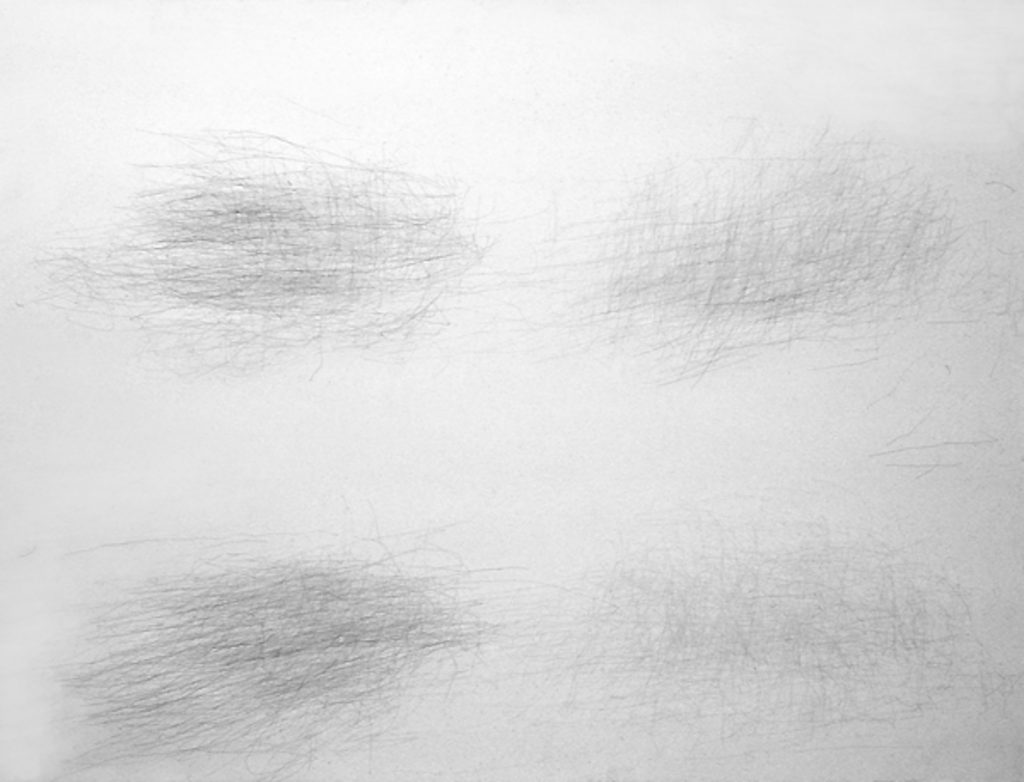
Anastasi’s drawings are not diaristic notations, but they can be seen as a kind of training diary, akin to a stenographer’s practice notebook. Like stenography, the drawings involve a sensitivity to the sensation of perception in a phenomenological sense (figs. 1, 6). A stenographer has to know how to listen; she must resist certain impulses and hear spoken words only as sounds that trigger muscle memory. A stenographer, like the various recording technologies Anastasi used in this period, repackages data, but inevitably the represented data contains variations because of human error. This is why many of the educational materials for stenographers are based on simulating the materiality of “real” books and magazines (fig. 7); they emphasize the behaviors associated with reading (such as turning pages, and looking at long sections of text) in order to associate stenographic notetaking with these physical process. When the training materials then shift to steno format in succeeding pages, the stenographer can read and write as smoothly as in standard type (fig. 8).15
Conversely, Anastasi puts a great deal of effort into making drawings, a culturally coded practice, quotidian and effortless—a reflexive response to regular activities such as walking and riding the subway. But just as what is quotidian is not without effort, neither are the gestures he uses to make these drawings. The marks in the Pocket Drawings (fig. 1) do not have the loose potentiality of scribbles, the sense that the artist is gathering together a point that eventually may be made. Instead, the graphite shows small, jagged passages of lines that evoke scratching an itch or boring a hole. The sheet of paper, an entanglement as well as a support, helps demonstrate that these gestures are not natural gestures; they are generated by an encounter that the artist has trained himself not to fully parse. The fidelity of Anastasi’s effort is not in question, but the data—the pencil marks—do not show anything. Instead, they reveal the mandate of intelligibility that culture, with its many institutions and codes, heaps upon the raw, phenomenological experience of the world. Within the matrix of the cloth envelope of Anastasi’s pocket, the blank recording surface bent like a textile in accordance with his body, and the jagged, randomly generated marks, one seeks a modicum of what Walter Benjamin calls translatability—that something is meant to be voiced or shown.16 And, in fact, the action has generated the terms of its translation. In an interview in 2014, Rachel Nackman asked Anastasi, “When do you decide that you will pull out the paper, unfold and refold it?” Anastasi replied, “That’s hard to answer, because it’s not as though I decide. In other words, I’m not consulting the drawing and saying, ‘Is that enough?’”17 The timing of his folding and marking is contingent on the impulsive decisions made by his body, which corresponds with its environment to create a system of materials all its own.
Video 1. William Anastasi making a subway drawing, Copenhagen-Holte train line, 1999, https://www.youtube.com/watch?v=H2FX3C7f6eI
Anastasi began making the Subway Drawings in the late 1970s on train trips to and from John Cage’s apartment in the Upper West Side for daily games of chess. They show how Anastasi uses his body to develop a craft and mechanism for drawing, but they also show that this craft is never too well developed or skilled, lest it attract the epithet of “slick art” so derided in Conceptual circles.18 A video showing the production of a subway drawing (video 1) is instructive here, revealing how Anastasi trains his body to rest capably within the vehicle that is his collaborator. He makes the works ambidextrously, producing the right and the left sides simultaneously (fig. 9). They can be stopped and started according to the artist’s preference in the moment, switched out for other drawings, and returned to later. An untitled Subway Drawing of 1975 shows the result of the recorded marks from several trips, with the top layer completed in a softer lead pencil than the lines beneath it. In the work of a professional stenographer, writing is also frequently bilateral; the steno notebook is divided in the middle by a horizontal line so that the notetaker need only write short phrases at a time, instead of long lines of content (fig. 10).


The Subway Drawings shift the work of recording and transcribing onto Anastasi’s body—a body that is prone to unconscious adjustments in response to the environment. This somatic approach relied on a thoughtless but nonetheless purposeful way of navigating public and private space, in line with the writings of Maurice Merleau-Ponty, whose text Phenomenology of Perception had been newly translated to English in 1962, and whom Anastasi encountered in dialogues with Robert Morris and John Cage.19 In their physical execution, the Subway Drawings anticipate (and engage with) more contemporary theories of habit, wayfinding, and alternative methods for negotiating space, particularly sightlessness.20


A closer look at the stenographic instructional texts is revealing here, as it shows the disciplinary practices that helped transform the human body into an efficient conduit for spoken content in modern capitalism. Duran Kimball’s book Business Shorthand (1900) describes the ideal position of ease to prepare the hand for the effort of writing: “The hand should assume its easiest position on the table, the position it would take naturally if dropped upon the table in a moment of rest, without thot [sic] or restraint, the knuckle of the fore-finger uppermost, the third and fourth fingers curved under the palm to form an elastic support to the hand and steady its movement across the paper. The wrist should be slightly raised, so that the hand may move freely.”21 Anastasi’s hands, by contrast, do not assume an easeful position for writing; instead, they grip the pens with five fingers, as though they were walking sticks (fig. 12). He retains some control of his body by eschewing writerly control, using the pens to calibrate his body position so that he always remains upright, back straight, abdominal muscles engaged but not tense. Occasionally he taps the page, as his body translates its surroundings precisely but unintelligibly. This is not a grip of practiced dexterity, nor is it showcasing the pliant body that André Masson and Salvador Dali described in Surrealist automatic writing sessions in which participants were “bound to their chairs by an ingenious system of straps, so that they could only move a hand in a certain way.”22 If anything, this resembles the Surrealist automatism described in the popular literature of the 1960s and 1970s, whose authors focused on reverie and wonder.23 In 1971, Roger Cardinal framed automatic writing as an ecstatic state, a “passionate manifestation of lunacy” (fig 13).24 But while Anastasi’s “lunacy” might seem evident here (the other train passengers clearly notice his non-normative behavior), it is in fact subtly controlled.

In the 1960s, many artists in Anastasi’s circle embraced everyday tasks and gestures as source material for their work. The sculptor Robert Morris and the choreographer Yvonne Rainer, who lived in the same studio building as Anastasi from 1964 to 1968, stand out in this regard. Rainer created task-based dances that were built around repeated bodily movements that “required no skill or little energy,” but she found her earliest experiments frustrating because it was difficult to make them look unremarkable within a timed dance performance. “Every time [an] ‘elbow-wiggle’ came up, one felt like applauding,” Rainer recalled.25 Morris, a sculptor, sought to make sculptural objects that “[broke] the tedious ring of ‘artiness’ circumscribing each new phase of art since the Renaissance.”26 The kinetic painter Carolee Schneemann, another neighbor, produced performance works with groups of individuals that she found on the street, individuals who might be “eating [their] soup in a beautiful way,” but lacked the established vocabulary of the trained dancer.27
These non-stylized movements and objects, however, became stylistic, or professional, once placed in a performance space or gallery. Still, Dore Ashton, as well as other major critics, valorized this unstylish, or amateurish, style, invoking such figures as the French philosopher Henri Bergson when she discussed imagination and creativity in her writing. In a 1965 essay, for instance, Ashton referenced Bergson five times, exemplifying the renewed attention in critical discourse of the 1960s to the deadening effects of the technologies of modern life and mass media. Ashton’s essay sought to expose the flaws inherent in purely intellectual ways of seeing the world, aligning with Bergson’s claim that “[t]he most living thought becomes frigid in the formula that expresses it.”28 By quoting Bergson alongside more recent scientific studies of brain activity, Ashton advanced the Bergsonian idea that that “intuition completes a vision of human experience which intellect cannot provide.”29
Anastasi’s drawings challenged Ashton’s elegant bifurcation of intuition and intellect. By embracing stupidity and rigidity, they exposed the grace of the body negotiating an organized system. It is interesting that Anastasi began referring to his own sculptures as “dumb art” and his drawings as “old-fashioned work” around this time, a move that seems to anticipate, and refuse, the possibility of being romanticized.30 A dumb artist is not even intuitive; he promises no secret revelations, as would the romantic model of the “naive” artist. Anastasi’s method is likewise distinct from the “fast thinking” that Donald Judd discussed in his reviews from the mid-1960s, in which an artist might articulate, with light and rapid effort, a possibility for arranging a quickly perceivable whole out of many parts.31 Instead of completing a vision, Anastasi was simply—to borrow John Cage’s phrasing—an “empty glass into which anything [could] be poured,” as at home in the studio as in the subway or on the sales floor32 Anastasi’s frequent intellectual sparring with Morris in this period makes his framing of himself as “dumb” even more interesting. While Anastasi was well-versed but self-taught in literature, philosophy, and art history, Morris had a graduate degree in the latter subject; Anastasi therefore positioned himself in opposition to the art history and formalist criticism that Morris often disavowed through parodies and strident polemics.33
The gendered connotations of professional stenography are also worth considering. By 1930, 95 percent of trained stenographers were women.34 In the bureaucratic culture of the postwar United States, the stenographer was continually associated with her omnipresent notebook or typewriter—as Friedrich Kittler put it, “the conversion of a profession, a machine, and a sex.”35 Even after the publication of the Diamond Jubilee shorthand textbooks in 1949, which made shorthand easier to learn, the stenographer was engaged, omnipresent, and servile but also at constant risk of making errors. Marcel Duchamp’s invocations of stenography, newly in print in the 1960s, would have illuminated for Anastasi the libidinal, liminal potential of servile collaborators.36 In fact, in a 1917 essay in The Blind Man, Mina Loy also mentions stenography as a tease directed at women in Dada and Surrealist circles; women were sometimes treated as stenographers and told to take dictation at parties.37
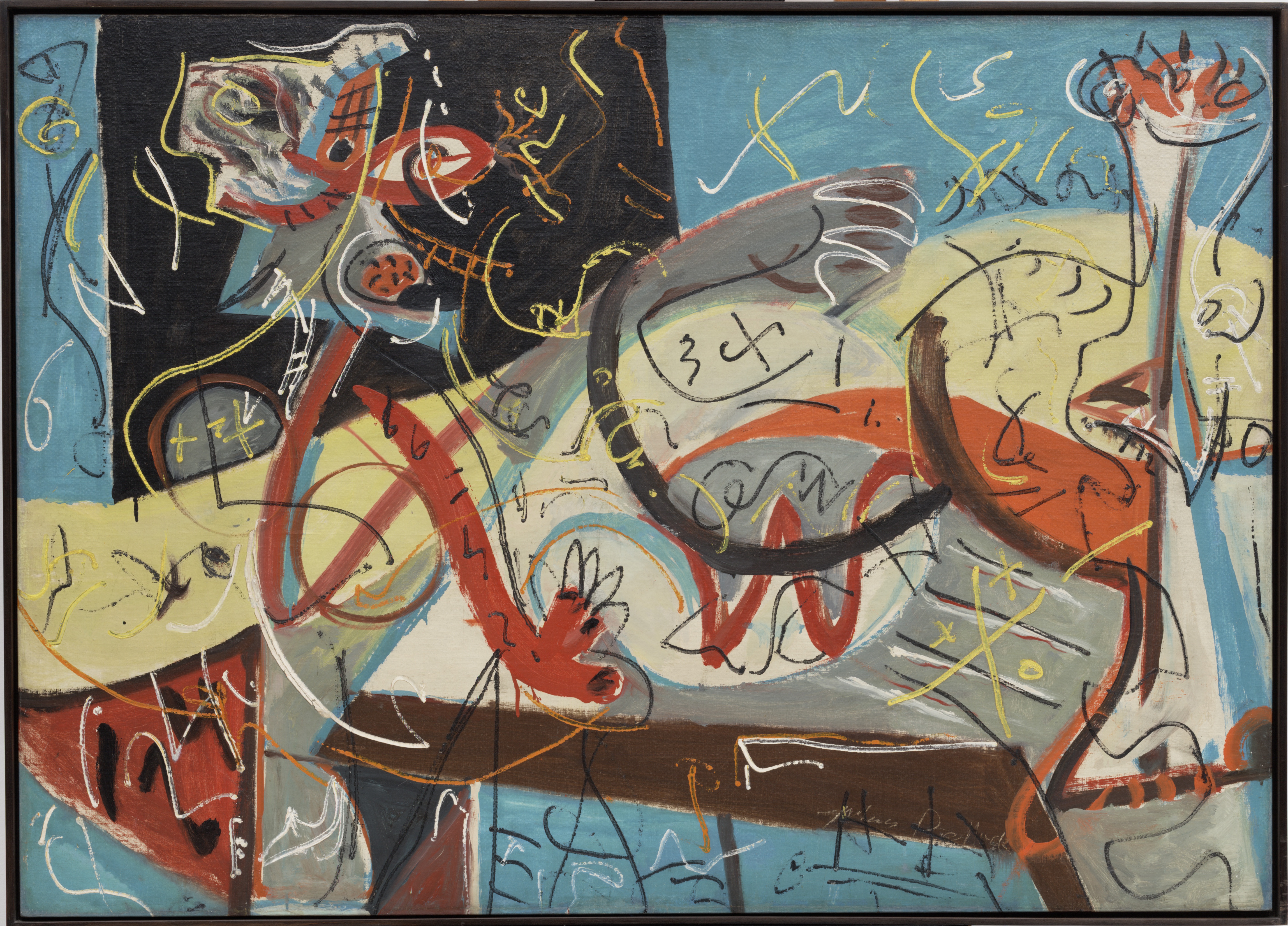
Susan Sontag argued that “atomistic visual stenography” was amateur and hackneyed, and indicative of a retrograde view of American culture. Sontag’s essay in On Photography about the poet Walt Whitman positions him as the impetus behind a uniquely American approach to picture making. She argues that Whitman’s poetry, particularly Leaves of Grass, approaches American life as an array of ordinary, singular, but all equally interesting set of subjects. His poetry worked to eliminate the value judgments that divided aesthetically worthy subjects from unworthy ones. Whitman believed that “the majesty and beauty of the world are latent in any iota of the world,” and Sontag notes that American photographers of the twentieth century labored to capture the beauty of ordinary subjects, such as city streets, immigration offices, and tenement buildings.38 Although Sontag uses the word “stenography” only once, and pejoratively, she mobilizes the term in a way that speaks uncannily to Anastasi’s project. She attributes the stenographic transcription of reality to a maker’s innocence and naivete—she all but calls it dumb art—but also compares it to meditation. She called Whitman’s verses “a psychic technology for chanting the reader into a new state of being . . . they are functional, like mantras—ways of transmitting charges of energy.” For Sontag, stenography was passé—a representational method that implied that “[n]o moment is more important than any other moment; no person is more interesting than any other person.”39
Another exploration of stenography in postwar New York art stands out. Jackson Pollock, whom Anastasi admired and met on several occasions, painted a canvas called Stenographic Figure that was shown after its completion in 1942 and again in Pollock’s 1967 retrospective exhibition at MoMA—an exhibition that Anastasi visited multiple times (fig. 14).40 Stenographic Figure has been an object of debate for art historians since its creation in 1942. The painting is difficult to read, both in terms of its iconography and the “written” lexicon of symbols painted throughout the composition. The consensus about this painting, however, is that it features a stenographer, seen at the left of the canvas, with both eyes positioned frontally and two arms reaching frantically out to a set of planes in front of her—likely several shorthand notation sheets. The subject may be advancing the paper feed mechanism on the side of a stenotype machine. Numbers, letters, and symbols are interspersed throughout the depicted objects and in the positive and negative spaces of the picture. It is likely that the male figure on the right, standing tall in a collared business shirt tucked into belted pants, is giving dictation to the stenographer. This is a scene of two people negotiating different languages, the seated female figure endeavoring to keep up with her transcription.
Scholars have noted that Pollock painted this canvas while in therapy with the Jungian analyst Violet Staub de Laszlo, with whom he discussed his drawings weekly.41 De Laszlo described Pollock, a high school dropout, as “inarticulate,” a “shut-in,” and “repressed.”42 Seen in this light, the central anxiety here is one about mastery and control of language and meaning: the stenographer on the left works frantically to process the ideas of the businessman on the right. Pollock may have seen himself as the stenographer “taking dictation” from the white-collar professional and therefore not fully in control of his own work. Sue Taylor writes, “It seems clear that much of Pollock’s treatment consisted of his therapists instructing him in the Jungian understanding of symbol formation and its function in his drawings and paintings.” 43 The painting also crystalizes a broader tension in the postwar New York art world, one that attenuated in Anastasi’s drawings: the anxiety experienced by self-taught or autodidactic artists who were negotiating their work and careers with and against professionals, including scholars, collectors, curators, and therapists. Anastasi, who came of age after Abstract Expression and the focus on the expressive self, distrusted the psychoanalytic framework; he refers to his work as “phenomenological rather than psychological.”44 The practice of stenography was then a fertile reference for Anastasi because it detached meaning from a single concept of knowing: its meaning emerged imprecisely through the exchange of sensory data, habit, reflex, and chance instead of from the diagnoses of trained experts.

Anastasi’s first solo show at the Dwan Gallery consisted of images of each blank wall of the gallery, which the artist had photographed and then silkscreened onto large canvases. He then hung the silkscreened canvases on their corresponding walls (fig. 15). These were exact reproductions at reduced scale and provided the illusion of the gallery walls being full and empty at the same time. Seizing on the grandiose scale of Abstract Expressionism, the terseness of monochrome painting, and the media-driven repetition of Pop, the wall-sized images indicate his fluency in the concept-practices of contemporary art discourse. Anastasi’s few reviews confirmed this. “Anastasi is obviously sharp as a tack,” observed Gregory Battcock in Arts Magazine in 1968. “He is intensely aware of what is happening in art and art criticism at this time. Cerebral integrity of this magnitude is rare. . . . There is no credibility gap here.”45 Battcock’s praise positions him firmly as an early and enthusiastic champion of Anastasi’s work, and the rhetoric of this panegyric, with its focus on credibility, is interesting. He compares the “incisive logic” of the work to that of Warhol, but not even Warhol’s earliest critics would have announced Warhol’s intelligence as “obvious.” This paean has the undertones of distant, polite praise, like a business school recommendation letter. Battcock assures the reader of Anastasi’s intellect and integrity because of the artist’s apparent refusal to create the work in the most familiar manifestation of registers: the empirical space of the picture plane.
Battcock’s 1968 review followed a series of proposals that Anastasi made to MoMA in October of 1967. He offered to make video recordings of the walls of the fifth-floor gallery and then project them onto the gallery walls. He also suggested making photographs of blank walls that would then be transferred to silkscreen. This transfer method, he reasoned, would highlight the minute characteristics of the surface of each wall. He also proposed a public performance featuring a professional stenographer. All were rejected.
Despite the institutional rebuff, Battcock discussed Anastasi’s proposals in another article, “Four Artists who Did Not Show in New York This Summer.” The article title illustrates the beginnings of a shift in professional benchmarks and critical standards. It implies that not having shown in New York—conventionally understood as a marker of professional failure—could instead be construed as liberating and constitutive of a powerful form of criticality. Battcock’s response to Anastasi’s MoMA proposals also praises the indictment of modern media culture and spectacle in the work. “The observer is left with nothing,” wrote Battcock of the artist’s tautological proposals. “Either you dig it or you don’t. It would seem that anybody disgusted with the hypocrisy, distortion and reaction characteristic of the modern world, is bound to find Anastasi’s idea worth, at least, considerable speculation.”46

“Hypocrisy, distortion, and reaction” was a barbed reference to the tendency in the New York art world to rehearse and replicate the politics of spectacle that were endemic to the modern media landscape. Anastasi’s projects of the late 1960s advance transcription as an antidote to constant reification, exemplified by how artwork was discussed less and less on its own merits, but instead as an extension of the artist as a media personality. “At present, the greatest outpouring of ideas comes after [art] events when friends gather to criticize the participants,” wrote Gordon Brown in 1966. Brown recalled that many of the criticisms that he overheard at gatherings referred to the physical mannerisms and personal presentation of the artists—characteristics that were read as markers of credibility. “‘Judd looked as if he were nervous,’ someone might say, or ‘Rauschenberg and Poons were the only ones who looked honest.’”47
One of Anastasi’s proposals to MoMA, a performance called You Are, problematizes this overly close attentiveness to gesture as a marker of credibility by using stenography to “read” gallery visitors. In 1977, the curator Alanna Heiss invited Anastasi to conceptualize it for the Clocktower Gallery, an alternative space inside a nineteenth-century architectural firm in lower Manhattan48 You Are included a narrator, a stenographer, and a court typist (fig. 16). Anastasi closed his eyes and instructed the narrator—on the opening night of You Are, the narrator was his friend John Cage—to describe each person who entered the room. The stenographer then wrote Cage’s description in shorthand and handed it over to a courtroom typist, who translated the shorthand back into roman text. This project, above all, puts the individual at a distance from how they are perceived in social space, using stenography and translation to show the possibilities for multiple ways of knowing.
By engaging with transcription technologies, both analogue and electronic, Anastasi inserted himself into dialogues about recording techniques and artistic agency, extending them beyond the Surrealist template. His drawings and performances complicate the relationship between aesthetics and social class, creating space for a form of know-how that was powerful and mobile precisely because it could appear inexpert and thoughtless. To walk with Anastasi was to witness a constantly shifting set of entanglements, each one keeping expertise at bay.
July 12, 2019: An earlier version of this article erroneously appeared without the second paragraph.
Cite this article: Katie Anania, “Walk with Me: William Anastasi’s Stenography of the Street,” Panorama: Journal of the Association of Historians of American Art 5, no. 1 (Spring 2019), https://doi.org/10.24926/24716839.1697.
PDF: Anania, Walk with Me
Notes
- According to Anastasi, this neighborhood, then just beginning to be called Alphabet City, was “{t}he cheapest {he} could find.” Anastasi, in “William Anastasi and Thomas McEvilley: A Conversation,” in Charles F. Stuckey, ed., William Anastasi: A Selection of Works from 1960 to 1989 (New York: Scott Hanson Gallery, 1989), 7. ↵
- Anastasi had solo exhibitions in 1966, 1967, and two exhibitions in 1970. He was included in all four of Virginia Dwan’s Language exhibitions from 1967 to 1970. A drawing by Anastasi was also part of the 1967 exhibition Scale Models and Drawings at the Dwan Gallery—the only work of Anastasi’s, in fact, that Dwan ever sold. See New York exhibition files, boxes 2–3, Dwan Gallery Records, Archives of American Art, Smithsonian Institution. ↵
- Quoted in Richard Milazzo, “Living at Bludgeon’s Height: Libido, Religion, and the Living History of Conceptual Art,” in Richard Milazzo, ed., William Anastasi (Modena: Emilio Mazzoli Galleria d’Arte Contemporanea), 8. ↵
- Anastasi speaks of his professional flexibility frequently in interviews. See Anastasi, in “William Anastasi and Thomas McEvilley,” 15; and William Anastasi, interviews with the author, February 13, 2013; June 15, 2016; and August 17, 2016. ↵
- Quoted in “William Anastasi discusses this drawing,” multimedia accompaniment to “Robert Brennan on William Anastasi,” in Art=Text=Art: Private Languages/Public Systems: Drawings, Prints & Artists’ Books from the Sally & Wynn Kramarsky Collection (Buffalo: UB Anderson Gallery, University at Buffalo, the State University of New York, 2013), http://artequalstext.aboutdrawing.org/william-anastasi. ↵
- Quoted in William Anastasi: A Retrospective, 1960–1995, (Philadelphia: The Galleries at Moore, Moore College of Art and Design, 1995), 25. ↵
- See Jean-Michel Rabaté and Aaron Levy, “Preface: Interpretation Becomes Art,” in Jean-Michel Rabaté and Aaron Levy, eds., William Anastasi’s Pataphysical Society: Jarry, Joyce, Duchamp, and Cage (Philadelphia: Slought Foundation, 2005), ix. ↵
- Anastasi has on occasion connected his own work to Surrealism, albeit playfully or indirectly. He collaborated on a book that attached him to Alfred Jarry, Marcel Duchamp, James Joyce, and Cage, and his essay for that book pointed out the many connections between Duchamp, Jarry, and the Surrealists. He has also mentioned automatic drawing in numerous interviews, conceding that the inspiration for his unsighted or automatic works in the early 1960s came through discourse on automatism and Abstract Expressionism. See Anastasi, “Jarry in Duchamp,” in Rabaté and Levy, William Anastasi’s Pataphysical Society, 33–34. See David Lomas, “Becoming Machine: Surrealist Automatism and Some Contemporary Instances,” Tate Papers no. 18 (Autumn 2012): https://www.tate.org.uk/research/publications/tate-papers/18/becoming-machine-surrealist-automatism-and-some-contemporary-instances; Milazzo, “Living at Bludgeon’s Height,” 11–57; and interviews with the author, February 13, 2013, and November 11, 2015. ↵
- See, for example, Julia Bryan-Wilson, Art Workers: Radical Practice in the Vietnam War Era (Berkeley: University of California Press, 2009); Francis Frascina, Art, Politics, and Dissent: Aspects of the Art Left in Sixties America (Manchester: Manchester University Press, 1999); and Julie Ault, ed., Alternative Art, New York, 1965–1985 (Minneapolis: University of Minnesota Press, 2002). ↵
- Bryan-Wilson, Art Workers, 15. ↵
- Roy Ascott, “The Construction of Change,” Cambridge Opinion 37, Modern Art in Britain (January 1964): 37. Quoted in Lucy Lippard, Six Years: The Dematerialization of the Art Object from 1966 to 1972 (Berkeley: University of California Press, 1997), 2. ↵
- Anastasi, interview with the author, December 27, 2018. ↵
- In interviews, Anastasi frequently concedes to his fascination with bureaucracy and infrastructure when he first began making work as a professional artist at the height of the Nuclear Age. “I found it so interesting that there was all this matter, all these buildings, that could be blown up in a blink of an eye. The sheer number of drivers, airplanes, and plane pilots that it would take to coordinate such destruction—we had it, right there, in America.” Anastasi, interview with the author, December 27, 2018. ↵
- Lomas in particular emphasizes passivity, positioning Anastasi’s projects as natural inheritors of Duchamp’s early experiments depicting human motion in his paintings. He proposes Duchamp’s painting Sad Young Man on a Train (1911–12; Peggy Guggenheim Collection, Venice), for instance, as both Duchamp and Anastasi experimented with, as Lomas puts it, “the passivity of a body acted upon by mechanical forces.” However, a couple of projects are also relevant when considering the emerging approaches to action and agency in downtown New York. In particular, Sol LeWitt’s works Run I–IV (1962; LeWitt Collection {I, II and III}; and Glenstone {IV}); and Muybridge I and Muybridge II (1964; LeWitt Collection), advance the proposition that physical action is always incommensurate with the technologies that seek to fix and record it. In positioning the camera as a machine that rigorously, invariably traces the human body without revealing many individual details about that body, LeWitt problematized the agency and primacy of the viewer. See Lomas, “Becoming Machine,” and James Meyer, “LeWitt at the Dwan Gallery,” in Minimalism: Art and Polemics in the Sixties (New Haven: Yale University Press, 2001), 200–8. ↵
- This behavioral approach to teaching Gregg shorthand, known as the Direct Method, gained ground in the 1930s, when a series of broad revisions to standard stenographic curricula would take effect in the United States. For more on this history, see Lindsey Jancay, “Shorthand and the Stenographic Image,” (master’s thesis, School of the Art Institute of Chicago, 2018). ↵
- Walter Benjamin, “The Task of the Translator,” in Marcus Bullock and Michael W. Jennings, eds., Walter Benjamin: Selected Writings, Volume 1: 1913–1926 (Cambridge, MA: Harvard University Press, 1996), 254. ↵
- “William Anastasi in conversation with Rachel Nackman, March 12, New York,” in Notations: Contemporary Drawing as Idea and Process, http://notations.aboutdrawing.org/william-anastasi. Accessed February 16, 2019. ↵
- Sol LeWitt, “Sentences on Conceptual Art,” first published in 0 To 9 (New York), 1969, and Art-Language (England), May 1969. Reprinted in Alicia Legg, ed., Sol LeWitt (New York: Museum of Modern Art, 1978), 168. ↵
- For a more detailed discussion of the spread of Maurice Merleau-Ponty’s work within Minimal and Conceptual circles in the mid-1960s, see James Meyer, “Morris’s ‘Notes on Sculpture,’” in Minimalism, 153–66. ↵
- Such texts include, for instance, Erin Manning, The Minor Gesture (Durham, NC: Duke University Press, 2016); Erin Manning and Brian Massumi, Thought in the Act: Passages in the Ecology of Experience (Minneapolis: University of Minnesota Press, 2014); Ellen Tani, Second Sight: The Paradox of Vision in Contemporary Art (New York: Scala Arts, 2018); Richard Shusterman, “Muscle Memory and the Somaesthetic Pathologies of Everyday Life,” in Thinking through the Body: Essays in Somaesthetics (Cambridge: Cambridge University Press, 2012), 91–111. See also the earliest works of social performance theory, such as two publications by Erving Goffman, The Presentation of Self in Everyday Life (Edinburgh: University of Edinburgh, 1956) and Relations in Public (Piscataway, NJ: Transaction Publishers), 1971. ↵
- Duran Kimball, Business Shorthand (Sydney, Australia: Wentworth Press, 1900), 9–10. ↵
- Salvador Dalí, “The Object as Revealed in Surrealist Experiment,” 1932, in Haim Finkelstein, ed., The Collected Writings of Salvador Dalí (Cambridge: Cambridge University Press, 1998), 236. ↵
- Numerous writings on Surrealism in the 1960s mention wonder or reverie, or they emphasize the benefits of intuitive, uncalculated ways of being. See, for instance, Annette Michelson, who in 1966 quoted André Breton: “diametrical, steadfast, and categorical opposition to any attempt at a definition of formal beauty in terms of a deliberate effort of perfection incumbent upon man,” or Lucy Lippard, in an introduction to her 1971 edited volume on Surrealists, or Roger Cardinal and Robert Stuart Short’s assertion that Surrealist techniques help to “recuperate man’s lost powers.” See Michelson, “Breton’s Aesthetics: The Peripeties of Metaphor,” Artforum 5, no. 1 (September 1966): 73; Lippard, ed., Surrealists on Art (Englewood Cliffs, NJ: Prentice Hall, 1974), 11–25; and Roger Cardinal and Robert Stuart Short, Surrealism: Permanent Revelation (London: Studio Vista/Dutton, 1970), 9. ↵
- Cardinal and Short, Surrealism, 60. ↵
- Yvonne Rainer, “A Quasi Survey of Some ‘Minimalist’ Tendencies in the Quantitatively Minimal Dance Activity Amidst the Plethora, or an Analysis of Trio A,” written in 1966 and first published in Gregory Battcock, ed., Minimal Art: A Critical Anthology (New York: Dutton, 1968), 270. ↵
- Robert Morris, “Notes on Sculpture, Part 3,” Artforum 5, no. 6 (Summer 1967): 128 ↵
- Bernard Green, “Gooey ‘Celebration’ to Happen at the Museum,” Chicago Sun-Times, January 11, 1968, 3B. ↵
- Henri Bergson, Creative Evolution, trans. Arthur Mitchell (New York: Henry Holt, 1911), 127. ↵
- Dore Ashton, “In Praise of Illusion,” Arts and Architecture 82, no. 3 (March 1965): 6–7, 34. Reprinted in Gregory Battcock, The New Art: A Critical Anthology (New York: E.P. Dutton, 1966), 121. ↵
- Anastasi, quoted in Stuckey, William Anastasi, 7; and interview with the author, February 13, 2013. ↵
- See Richard Shiff, “Donald Judd: Fast Thinking,” in Donald Judd Late Work (New York: Pace Wildenstein, 2000), 4–23. ↵
- John Cage, “Lecture on Nothing,” Incontri Musicali no. 3 (August 1959): 19. Reprinted in Cage, Silence: Lectures and Writings (Middletown, CT: Wesleyan University Press, 1961), 110. ↵
- James Meyer points out that Robert Morris’s strongest contribution to art criticism—“Notes on Sculpture,” one and two, which he published in 1966—began as a parody of the formalist criticism of Clement Greenberg and Michael Fried. Anastasi’s approach took a resolutely amateurish approach to art history and technical knowledge generally, in contradistinction to Morris’s appropriations. See Meyer, Minimalism, 155. ↵
- Janet M. Hooks, “Women’s Occupations Through Seven Decades,” United States Department of Labor, Women’s Bureau Bulletin, no. 218 (1947): 75. ↵
- Friedrich Kittler, Gramophone Film Typewriter (Stanford: Stanford University Press, 1999), 183. ↵
- In Duchamp’s manuscript notes, exhibited at MoMA in 1966, he wrote about his own experiments with mechanical actions as having the potential to produce a new alphabet of visual forms, an “ideal stenography” that could serve as “a language of phenomena themselves.” In fact, Duchamp rested the entire visual vocabulary of The Bride Stripped Bare by Her Bachelors, Even on the possibility that the bride and other figures could be interchanged with text. See David Joselit, Infinite Regress (Cambridge, MA: MIT Press), 55; Marcel Duchamp, À l’Infinitif (La Boîte Blanche) {In the Infinitive (The White Box)}, 1912–20, published 1966, Museum of Modern Art, New York. Linda Henderson expands upon stenography in her book Duchamp in Context: Science and Technology in the Large Glass and Related Works (Princeton: Princeton University Press, 1998), 106; and Charles A. Cramer examines Duchamp’s references to stenography and translation in “Duchamp from syntax to bride: Sa langue dans sa joue,” Word and Image 13, no. 3 (1997): 279–303. ↵
- Mina Loy, “O Marcel—Otherwise I Have Also Been to Louise’s,” in The Blind Man 2 (May 1917): 14. ↵
- Walt Whitman, preface to 1855 edition of Leaves of Grass, as quoted in Susan Sontag, On Photography (New York: Farrar, Strauss, and Giroux, 1977), 23. Originally printed as “Freak Show,” New York Review of Books, November 15, 1973, 13–19. ↵
- Susan Sontag, On Photography, 22. ↵
- Anastasi attributes his interest in automatic painting and drawing to Pollock and has stated that his early walking drawings and Constellation Drawings were inspired by Abstract Expressionism. “How expressionist can you get?” Anastasi recalls of these drawings, emphasizing their dialogue with the inheritance of gestural abstraction. Quoted in Anastasi, in “William Anastasi and Thomas McEvilley” in Stuckey, William Anastasi, 7. ↵
- See Sue Taylor, “The Artist and the Analyst: Jackson Pollock’s ‘Stenographic Figure,’” American Art 17, no. 3 (October 2003): 177. ↵
- Dr. Violet Staub de Laszlo, letter to the Examining Medical Officer of the Selective Service System, May 3, 1941, Archives of American Art, Smithsonian Institution. Sue Taylor confirms that Pollock’s previous Jungian analyst, Dr. Joseph Henderson, also noted that Pollock was “extremely repressed.” See Taylor, “The Artist and the Analyst,” 177. ↵
- Taylor, “The Artist and the Analyst,” 180. ↵
- See Anastasi, “William Anastasi and Thomas McEvilley,” in Stuckey, William Anastasi, 15; and interview with the author, February 13, 2013. ↵
- Gregory Battcock, “William Anastasi: In the Galleries,” Arts Magazine 5, no. 6 (Summer 1967): 110. ↵
- Gregory Battcock, “Four Artists Who Did Not Show in New York This Summer,” Arts Magazine 42, no. 8 (Summer 1968): 79. ↵
- Gordon Brown, “Art Trends: Art for Talk’s Sake,” Arts Magazine 41, no. 3 (December 1966–January 1967): 53. ↵
- The Clocktower Gallery programs in the 1970s were devoted to creative merging of art and urban space, including the politicized use of office spaces. It is possible that Alanna Heiss found the clerical component of Anastasi’s work attractive and arranged for him to be accorded the budget for three different speakers for the three nights of the performance. See Ault, Alternative Art, New York, 1965–1985, 33, 270; also confirmed in William Anastasi, interview with the author, December 26, 2018. ↵
About the Author(s): Katie Anania is Assistant Professor of Art History at Georgia College


